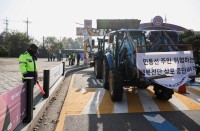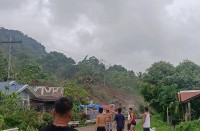ROHTAK and HANIPAT, HARYANA, India (Reuters) — A week-long protest by India’s Jat community, a rural caste, has left a trail of destruction in Rohtak city, in the country’s northern Haryana state.
The protesters gutted several showrooms of automobile companies. They also attacked shopping malls and looted and destroyed shops. A school building was torched and several buses parked in the premises were destroyed.
Rohtak was one of the worst affected districts in the state, after demonstrations left at least 19 people dead.
On Tuesday (February 23), Haryana Chief Minister, Manohar Lal Khattar, visited the city to take stock of the situation. He also ordered an investigation into the violence.
“People have lost their lives and many shops have been destroyed. Some shops were robbed as well. I have seen the trail of destruction and I even got to know that some shops were targeted and destroyed. I assure you that everyone will be compensated for their loss,” said Khattar.
Meanwhile, normality slowly returned to Sonipat city, also in Haryana, as some traders reopened their shops.
“Sonipat was peaceful all through the protest. But there was trouble on the highway. So people in the city were scared. Today things are normal,” said a resident, Naveen.
Leaders of the Jat community reached a deal late on Monday (February 22) to end protests that paralysed Haryana and cut water supplies to Delhi’s 20 million residents, after winning a pledge of more government jobs.
Days of rioting and looting across Haryana by the Jat community challenged Prime Minister Narendra Modi’s promise of better days for Indians who elected him in 2014 with the largest majority in three decades.
Thousands of troops were deployed to quell the protests, which flared again on Monday near Sonipat when a freight train was torched. In neighbouring Rajasthan, Jats attacked and burned buses.
Disruption has been huge, with 850 trains cancelled, 500 factories closed and business losses estimated at up to $5 billion by one regional lobby group.
Many Jats, who number more than 80 million across north India, are farmers whose livelihoods have suffered as families divide farms among their children. Two years of drought have harmed crops, and they are also missing out on urban jobs.
Their demands for government jobs and student places are based on affirmative action policies that are typically reserved for deprived groups.
The Supreme Court has previously struck down an attempt to classify the Jats as an Other Backward Caste, or OBC, which would formally entitle them to a quota of jobs and student places.
The Jats predominantly voted for Modi’s Bharatiya Janata Party (BJP) in the 2014 general election, when he won the biggest parliamentary majority in three decades. Months later the BJP won an outright majority in Haryana for the first time.
Although many of the state’s chief ministers have been Jats, the current minister is not. Commentators have faulted him and other BJP leaders for failing to read the social mood and devoting too much attention to issues like cow protection that are a core part of the party’s pro-Hindu agenda.








